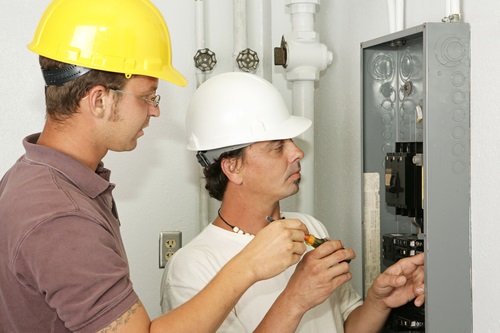Electricity makes a pit stop on the way from the utility company to your outlets. That’s the breaker panel, where electricity gets controlled and distributed safely to the circuits throughout the building. The breaker panel is where you can shut off power to individual rooms while doing home improvement. All panels function pretty much the same way, but there are some distinct differences — the location of the main shut-off switch and how many circuit breakers can be installed.

Main Breakers vs. Main Lugs
There’s one big difference between the common main breaker panel and a main lug panel. Main breakers have a master disconnect (shut-off switch) and lug panels do not.
Main breaker panels are the typical control center for a single-family home or detached building. One main breaker controls power for the entire system, while a circuit breaker panel controls individual branches.
If the panel needs to be more than a few feet away from the meter, you should use a main lug panel instead. A main disconnect gets installed near the meter, and the lug panel can go wherever you want. The lug panel has circuit breakers for individual areas of the home, it just lacks the main disconnect.
Sub-Panels
Many situations call for sub-panels: multi-family dwellings, office spaces, detached guest houses, home additions, or anywhere else that you need control over circuits separate from the main breaker panel. Sub-panels let tenants control their own circuits. It can also be handy if you want quick, convenient access to the breakers in a workshop or other unique location.
A lug panel can be used as a sub-panel, but there are sub-panels made specifically for this purpose.
Important: Sub-panels only provide more control over more circuits. Installing a sub-panel does not by itself increase the total power available — that requires a service upgrade in coordination with your utility company.
Types of Breakers
A breaker panel can use a variety of breaker types, limited only by the number and size of the available slots.
The primary types of switches on the breaker panel include:
- Single-pole: The normal 120v breaker for most circuits with outlets and lights
- Double-pole: The 240v breakers for major appliances
- GFCI: Switches with ground fault protection for an entire circuit (like the GFCI outlets in wet areas)
There are various sizes and types of breaker switches, but those are mostly for specific commercial uses.
Do I Need a New Breaker Panel?
If you have a fusebox or other “vintage” type of service panel, it’s definitely best to upgrade to a new breaker panel. Modern equipment better protects you and your property. Compared to older equipment, a new panel will probably mean less flickering lights and more reliable power — and it’s easier to flip a tripped breaker than it is to replace a blown fuse.
Insufficient power? First, check the amperage of your breaker panel. If it’s an old 60-amp panel you probably need to upgrade service from the utility to at least 100 amps. Larger homes might need more than 100. If you have enough circuit breakers, or you have open slots to add more, you might not need a new breaker panel. But it’s probably a good idea, if your electrical panel was installed at a time when 60 amps was the norm!
If you need more separate circuits but do not have open slots to add them on your current panel, you can upgrade to a larger breaker panel or add a sub-panel. Contact us for consultation.

